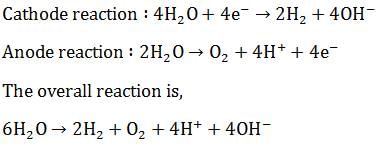Class 8 Exam > Class 8 Questions > Electrolysis of mgso4?
Start Learning for Free
Electrolysis of mgso4?
Verified Answer
Electrolysis of mgso4?
The electrolysis of an aqueous solution of magnesium using inert electrodes produces hydrogen at the cathode and oxygen at the anode and neutral solution of magnesium sulphate remains unaltered by the electrolysis.

 This question is part of UPSC exam. View all Class 8 courses
This question is part of UPSC exam. View all Class 8 courses
Most Upvoted Answer
Electrolysis of mgso4?
Electrolysis of MgSO4:
Electrolysis is a process in which an electric current is passed through an electrolyte to produce chemical changes. When it comes to the electrolysis of MgSO4 (magnesium sulfate), the compound dissociates into its constituent ions, magnesium ions (Mg2+) and sulfate ions (SO4^2-), in an aqueous solution. The process of electrolysis can be explained in detail as follows:
1. Electrolyte Solution:
MgSO4 is dissolved in water to form an electrolyte solution. This allows the ions to move freely in the solution and facilitates the flow of electric current.
2. Electrolysis Apparatus:
An electrolysis apparatus consists of two electrodes, namely an anode and a cathode, which are connected to a direct current (DC) power source. The anode is usually made of an inert material like platinum while the cathode can be made of various materials.
3. Cathode Reaction:
At the cathode, positive ions are attracted and undergo reduction. In the case of MgSO4 electrolysis, the Mg2+ ions are reduced to magnesium metal (Mg) at the cathode. The reduction reaction can be represented as follows:
2Mg2+ + 2e- → 2Mg
4. Anode Reaction:
At the anode, negative ions are attracted and undergo oxidation. In the case of MgSO4 electrolysis, the sulfate ions (SO4^2-) are oxidized to oxygen gas (O2) and water (H2O) at the anode. The oxidation reaction can be represented as follows:
2H2O → O2 + 4H+ + 4e-
4SO4^2- → 2O2 + 2S2O8^2-
5. Overall Reaction:
The overall reaction during electrolysis of MgSO4 can be obtained by combining the cathode and anode reactions. It can be represented as follows:
2Mg2+ + 4H2O + 4SO4^2- → 2Mg + 2O2 + 4H+ + 4S2O8^2-
6. Observations:
During the electrolysis of MgSO4, several observations can be made:
- Bubbles of oxygen gas are evolved at the anode.
- Magnesium metal is deposited at the cathode.
- The electrolyte solution may change in color or appearance due to the formation of other products.
In conclusion, the electrolysis of MgSO4 involves the dissociation of the compound into magnesium and sulfate ions, followed by their respective reduction and oxidation reactions at the cathode and anode. This process allows for the separation of magnesium metal and the production of oxygen gas.
Electrolysis is a process in which an electric current is passed through an electrolyte to produce chemical changes. When it comes to the electrolysis of MgSO4 (magnesium sulfate), the compound dissociates into its constituent ions, magnesium ions (Mg2+) and sulfate ions (SO4^2-), in an aqueous solution. The process of electrolysis can be explained in detail as follows:
1. Electrolyte Solution:
MgSO4 is dissolved in water to form an electrolyte solution. This allows the ions to move freely in the solution and facilitates the flow of electric current.
2. Electrolysis Apparatus:
An electrolysis apparatus consists of two electrodes, namely an anode and a cathode, which are connected to a direct current (DC) power source. The anode is usually made of an inert material like platinum while the cathode can be made of various materials.
3. Cathode Reaction:
At the cathode, positive ions are attracted and undergo reduction. In the case of MgSO4 electrolysis, the Mg2+ ions are reduced to magnesium metal (Mg) at the cathode. The reduction reaction can be represented as follows:
2Mg2+ + 2e- → 2Mg
4. Anode Reaction:
At the anode, negative ions are attracted and undergo oxidation. In the case of MgSO4 electrolysis, the sulfate ions (SO4^2-) are oxidized to oxygen gas (O2) and water (H2O) at the anode. The oxidation reaction can be represented as follows:
2H2O → O2 + 4H+ + 4e-
4SO4^2- → 2O2 + 2S2O8^2-
5. Overall Reaction:
The overall reaction during electrolysis of MgSO4 can be obtained by combining the cathode and anode reactions. It can be represented as follows:
2Mg2+ + 4H2O + 4SO4^2- → 2Mg + 2O2 + 4H+ + 4S2O8^2-
6. Observations:
During the electrolysis of MgSO4, several observations can be made:
- Bubbles of oxygen gas are evolved at the anode.
- Magnesium metal is deposited at the cathode.
- The electrolyte solution may change in color or appearance due to the formation of other products.
In conclusion, the electrolysis of MgSO4 involves the dissociation of the compound into magnesium and sulfate ions, followed by their respective reduction and oxidation reactions at the cathode and anode. This process allows for the separation of magnesium metal and the production of oxygen gas.

|
Explore Courses for Class 8 exam
|

|
Electrolysis of mgso4?
Question Description
Electrolysis of mgso4? for Class 8 2025 is part of Class 8 preparation. The Question and answers have been prepared according to the Class 8 exam syllabus. Information about Electrolysis of mgso4? covers all topics & solutions for Class 8 2025 Exam. Find important definitions, questions, meanings, examples, exercises and tests below for Electrolysis of mgso4?.
Electrolysis of mgso4? for Class 8 2025 is part of Class 8 preparation. The Question and answers have been prepared according to the Class 8 exam syllabus. Information about Electrolysis of mgso4? covers all topics & solutions for Class 8 2025 Exam. Find important definitions, questions, meanings, examples, exercises and tests below for Electrolysis of mgso4?.
Solutions for Electrolysis of mgso4? in English & in Hindi are available as part of our courses for Class 8.
Download more important topics, notes, lectures and mock test series for Class 8 Exam by signing up for free.
Here you can find the meaning of Electrolysis of mgso4? defined & explained in the simplest way possible. Besides giving the explanation of
Electrolysis of mgso4?, a detailed solution for Electrolysis of mgso4? has been provided alongside types of Electrolysis of mgso4? theory, EduRev gives you an
ample number of questions to practice Electrolysis of mgso4? tests, examples and also practice Class 8 tests.

|
Explore Courses for Class 8 exam
|

|
Signup for Free!
Signup to see your scores go up within 7 days! Learn & Practice with 1000+ FREE Notes, Videos & Tests.


























